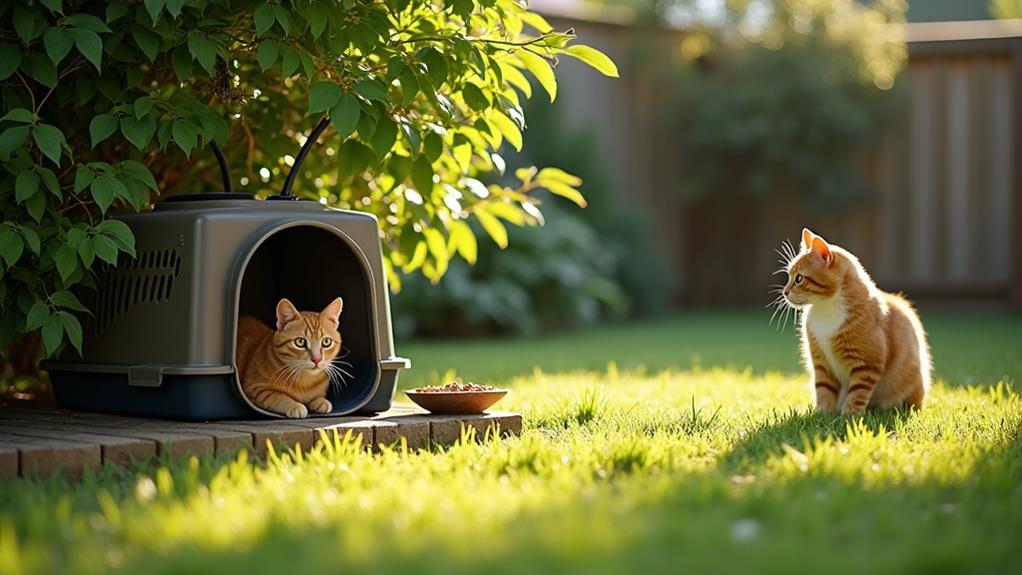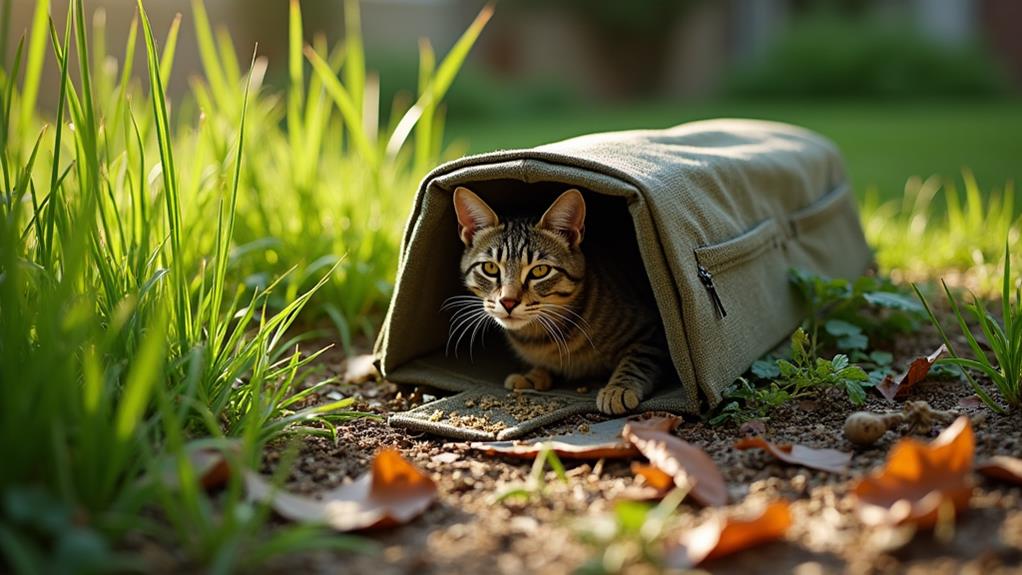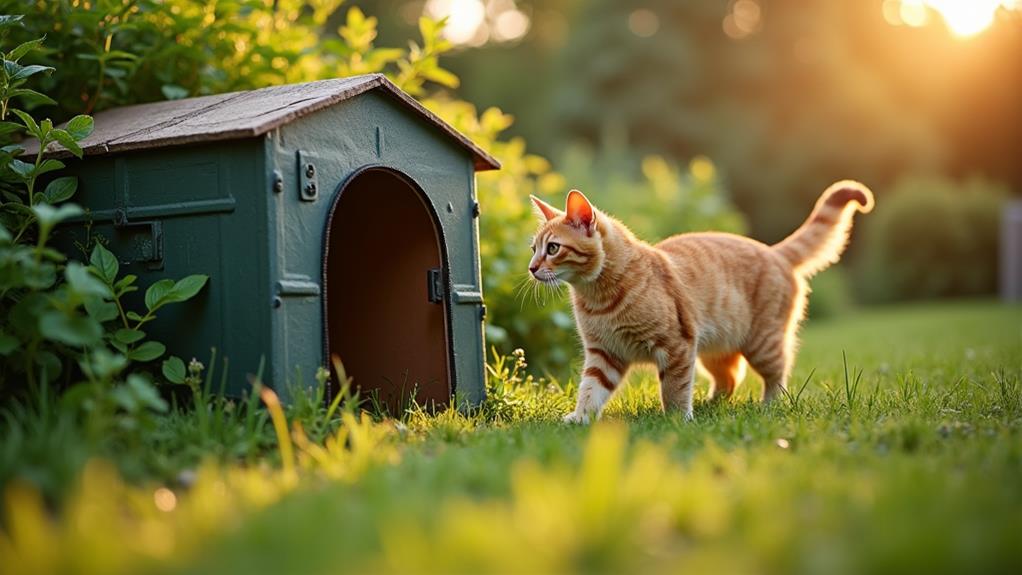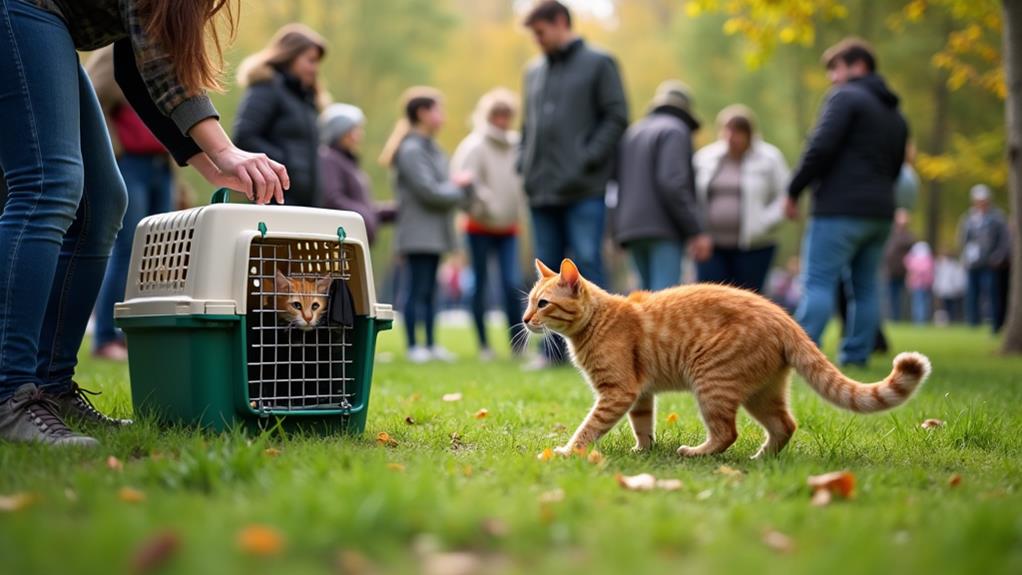How to Catch a Feral Cat Safely and Humanely

To catch a feral cat safely and humanely, begin by selecting a humane box trap and placing it in a quiet, sheltered area. Line the trap with newspaper for comfort and always clean it to remove scents. Use strong-smelling bait like tuna or sardines and position it behind the trip plate. Regularly check the trap to avoid leaving it unattended, and cover it with a blanket once a cat is inside to minimize stress. Handle the trapped cat gently and keep it in a secure environment. There's more to the process to guarantee a compassionate approach throughout.
Selecting the Right Traps
When you're choosing the right traps for capturing feral cats, it's vital to focus on humane box traps, as they're specifically designed to guarantee the safety and well-being of the animals. These traps secure the ethical capture of feral cats without causing them harm or stress. Consider using larger traps for more wary cats, as they offer increased comfort with taller openings and wider sides, making it easier for hesitant felines to enter.
Position your traps in secluded areas, away from busy zones, to create a calm and stress-free environment. This strategic placement helps increase the likelihood of capturing the feral cat while safeguarding their safety. To make the trap inviting, use strong-smelling bait like tuna or sardines. The familiar scent of food can attract the cats, making them more likely to investigate the trap.
It's critical to regularly inspect your traps for any damage and clean them with warm, soapy water after each use. This maintenance keeps the traps effective and safe for future trapping efforts. By following these guidelines, you'll be better equipped to humanely capture feral cats while prioritizing their safety and comfort.
Preparing Your Trapping Area
To effectively prepare your trapping area, start by establishing a consistent feeding routine at the location for at least a week. This routine helps feral cats become familiar with the area, building their trust and making it easier to eventually use traps. Choose a quiet area away from high-traffic zones to guarantee the cats feel secure. Avoiding disturbances is essential for their comfort and makes them more likely to approach the traps without hesitation.
Set up your traps in a sheltered area to protect the cats from adverse weather conditions like rain or extreme heat. This guarantees the humane treatment and safety of the cats once trapped. For added comfort and security, line the bottoms of the traps with newspaper. Cover traps with fabric or towels; this helps calm the cats by reducing their stress levels once inside.
Always clean traps thoroughly after each use with warm, soapy water to eliminate any human scents. This step is significant as lingering odors can deter future captures. By doing so, you create a more welcoming and trustworthy environment, promoting a humane way to manage feral cat populations.
Effective Baiting Strategies

Bait selection is vital when trapping feral cats, as the right aroma can greatly improve your chances of success. Strong-smelling baits like tuna, mackerel, or sardines are particularly effective. Their powerful odor can quickly attract cats, drawing them toward the trap. To optimize effectiveness, place the bait at the back of the trap, behind the trip plate. This placement guarantees that cats fully enter before triggering the door, increasing your chances of a successful capture.
Experimenting with different bait options can also prove advantageous. Besides tuna or sardines, you might try baby food (without onions) or a sprinkle of catnip to see what works best for the specific cats in your area.
Before setting out the trap, clean it thoroughly to remove any human scents. This step is vital; even a trace of human odor can deter cats from approaching. Use fresh catnip or sardine oil to mask any remaining smells and improve the bait's appeal. Moreover, limit food availability outside the trap during your efforts. By removing external food sources, you motivate the cats to enter the trap in search of food, increasing the likelihood of success.
Monitoring and Handling Traps
Monitoring and handling traps effectively is crucial for the safety and well-being of both the feral cats and yourself. Start by making sure you never leave a trap unattended. Regularly check the trap from a distance to confirm any captured cats are safe and to prevent theft or unauthorized release. Once a cat is captured, immediately cover the trap with a towel or blanket. This helps calm the cat by reducing stress and fear while they wait for transport or veterinary attention.
Create a calm environment around the trapping site. Avoid loud noises and sudden movements that might startle the trapped cat, increasing their anxiety. When handling the captured cat, keep it inside the trap until you can move it to a safe, temperature-controlled area. This minimizes the risk of stress or injury during transport.
After you've finished trapping, always count the number of traps used. This guarantees none are left behind, which could accidentally trap or abandon a cat. Proper monitoring and handling of traps not only protect the feral cats but also contribute to a humane and efficient trapping process. Your diligence in these steps guarantees the cats' safety and overall welfare.
Dealing With Trap-Shy Cats

After mastering the basics of monitoring and handling traps, it is crucial to address the challenge of dealing with trap-shy cats. These wary felines often need a more nuanced approach to feel at ease around traps. Start by creating positive associations with the traps. This can be achieved through feeding the cats inside un-set traps for over a week. Doing so helps them associate the trap with food rather than danger, enhancing their comfort level.
Gradual exposure is key. Place the traps in familiar areas where the cats already feel safe. This, along with food rewards, can greatly reduce their fear. If you notice specific triggers that frighten the cats, work on reconditioning these responses with patience. Don't rush this process, as hastiness can worsen their reluctance to enter traps.
Consider using larger traps with taller openings and wider sides, as these provide more comfort for trap-shy cats and make them less likely to shy away. Take short breaks from trapping efforts, ideally lasting one to two weeks, to allow the cats to regain their confidence. With time and patience, you'll successfully manage and trap these cautious creatures.
Post-Trapping Care Essentials
Once you've successfully trapped a feral cat, the next key step is guaranteeing their comfort and safety. Immediately cover the trap with a blanket or towel. This simple action greatly reduces stress by creating a calm environment for the cat. When you're ready to transport the cat, keep the trap covered and place it on a flat surface. Use absorbent materials like puppy pads or newspaper in the trap to handle any accidents during the trip.
After transporting, it's critical to keep the cat in a secure, temperature-controlled area where they aren't exposed to excessive noise or disturbances, as this can greatly elevate their stress levels. Follow all care instructions from your veterinary clinic closely. Monitoring the cat's recovery, especially after surgery, is fundamental. Look for any signs of complications or distress, and verify the cat is fully recovered from anesthesia before considering release.
Lastly, make certain the release location is safe and familiar to the cat, as this greatly aids in their adaptation back into the environment. By carefully managing these post-trapping care priorities, you'll support the cat's health and well-being throughout this process.
Safe Release and Community Support

Releasing a feral cat safely requires careful planning and consideration to guarantee their well-being. Start by making sure you return the cat to its original location. This prevents abandonment issues and aligns with legal and ethical standards, as relocating feral cats can harm their well-being. Check that the release area is safe, free from hazards like busy streets, allowing the cat to shift smoothly back to its environment. Keep traps covered until release to minimize stress and gently tilt the trap to encourage them to exit calmly.
Community support plays a vital role in this process. Reach out to local animal welfare organizations for resources and education on humane trapping and releasing practices. These groups can provide invaluable assistance and guidance throughout the process. It's also fundamental to engage with neighbors and local residents to raise awareness about the importance of supporting feral cat populations. By doing so, you can foster a collaborative approach to managing local cat colonies that benefits everyone involved. Encourage local residents to participate, creating a network that supports these efforts and guarantees the cats are safely and humanely integrated back into the community.




